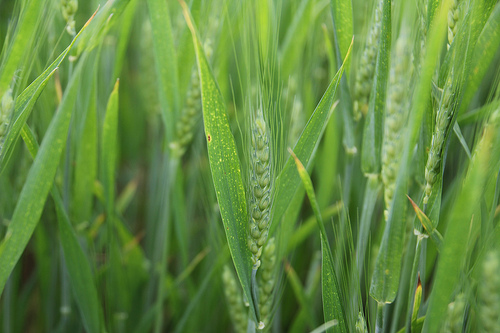
Agricultural News
Wheat Disease Issues More Prominent in Kansas Than in Oklahoma
Sun, 13 May 2012 16:47:30 CDT
 The latest wheat disease update has been released by Dr. Bob Hunger of Oklahoma State University- and as the 2012 wheat crop moves very quickly to maturity, Hunger sees limited problems in the Oklahoma crop from disease pressures. He, along with other wheat industry watchers, have seen lots of white heads this year- but most of that seems to be on wheat that produced a lot of tillers, more than the plant could support all the way to maturity, so they were sloughed off after the head was established.
The latest wheat disease update has been released by Dr. Bob Hunger of Oklahoma State University- and as the 2012 wheat crop moves very quickly to maturity, Hunger sees limited problems in the Oklahoma crop from disease pressures. He, along with other wheat industry watchers, have seen lots of white heads this year- but most of that seems to be on wheat that produced a lot of tillers, more than the plant could support all the way to maturity, so they were sloughed off after the head was established.
Dr. Hunger does provide the latest information available to him from Kansas-and farmers in that state are battling a lot of rust foliar disease problems.
Here's the two state reports as provided by Dr. Bob Hunger of OSU:
Oklahoma: Not much different from around Oklahoma. Field days and trips during this past week to northern Oklahoma (Kildare north of Ponca City) and then west from there to Lahoma (15 miles west of Enid) showed that wheat was moving quickly to maturity. There was no (or only very little) green foliage left on any varieties. White heads and/or plants with a whitish cast were prevalent across northern Oklahoma, but only occasionally were symptoms of root rot found associated with these plants. Generally the bases of tillers, crowns, and roots were mostly creamy white in color. When a root rot was found, the symptoms were most typical of dryland root rot with an occasional sharp eyespot.
The diagnostic lab received numerous wheat samples over the last week. Nearly all of these were from northern, northwestern, or the panhandle of OK. Again, only occasionally were symptoms indicative of root rot observed, and the whitish cast, white heads and/or white plants were likely due to a combination of drought and heat over the last couple of weeks combined with a mild winter that allowed many varieties to produce large numbers of tillers. An excellent and more detailed explanation of this has been written by Dr. Jeff Edwards (Small Grains Extension Agronomist, Oklahoma State University) and is available by clicking here.
Kansas: Dr. Erick De Wolf (Extension Plant Pathologist, Kansas State University) 11-May-2012: "The wheat in Kansas continues to develop ahead of schedule with most farmers and agronomists indicating the crop is 2-3 weeks ahead of schedule. Most of the wheat in KS is now moving through the grain filling stages of growth. Wheat in north central and northwestern KS was flowering and early stages of kernel development this week. The wheat is showing signs of rapid maturity in many areas of west central, southwestern and south central counties. The rapid maturity appears to be the result of periodic heat stress and persistent dry conditions in the past 2-3 weeks.
I observed active stripe rust in Ellis county near Hays (central KS) and Finney county in irrigated research plots near Garden City (Southwest). Jeanne Faulk and Cody Miller, KSU Exension Agronomy Agents, report that stripe rust remains active in northwest and north central Kansas. The progress of stripe rust has slowed dramatically in other areas of the state where environment has accelerated the maturity of the wheat crop.
Leaf rust is also contributing to the decline of wheat in many South central counties. Research plots of varieties known to be susceptible to leaf rust now have disease severity greater than 40% on the flag leaves. Varieties affected include Overley, Jagalene, Jagger, Fuller, PostRock. Lower leaves have been destroyed in previous weeks by combinations of environment (hot-dry conditions), leaf spotting disease, stripe rust, leaf rust. Of these varieties, Fuller and PostRock still hold a reasonable amount of acres in the state.
Barley yellow dwarf has also been a significant issue again this year. The disease can be found in nearly all fields where it is causing moderate size patches. Some fields showing more than 60% incidence of BYD.
WebReadyTM Powered by WireReady® NSI
Top Agricultural News
More Headlines...



















